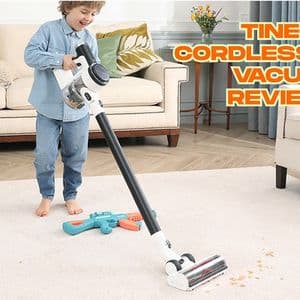Introduction
Cordless vacuums have reshaped how we clean our homes. No longer tethered to outlets or restricted by cords, users can move freely from room to room. Among these, the Dyson V8 remains one of the most referenced models—but how does it compare to others in the same category?
If you’re curious about how it stacks up, this guide provides a detailed breakdown of the Dyson V8’s position in the competitive landscape of cordless vacuums.
A Look at the Dyson V8: Core Features
Before diving into comparisons, it’s helpful to understand what the Dyson V8 brings to the table.
Design and Build
The Dyson V8 features a sleek, lightweight frame that’s easy to handle. It typically includes multiple cleaning attachments and a wall mount, making storage effortless.
Filtration System
It comes with a whole-machine HEPA filtration system designed to trap allergens, making it a solid option for homes with allergy sufferers.
Battery and Runtime
One of the Dyson V8’s standout features is its battery life. On a full charge, it can run up to 40 minutes without a motorized tool or around 25 minutes with one engaged. For a mid-range model, this was a game changer at launch.
Dyson V8 vs Dyson V10 and V11
Here’s where things get interesting.
Power and Suction
The V10 and V11 models offer higher suction power than the V8. For context, the V8 generates about 115 Air Watts, while the V10 and V11 offer 140 and 185 Air Watts respectively. This difference is notable when dealing with heavy debris or thick carpets.
Runtime Comparison
Both V10 and V11 provide longer runtimes—up to 60 minutes for the V10 and around 60–70 minutes for the V11, depending on the cleaning mode. This matters for larger homes or extended cleaning sessions.
Noise Levels
The Dyson V8 is quieter than both newer models. While noise isn’t always a deal-breaker, it’s worth noting for users in shared spaces or households with pets and young children.
Dyson V8 vs Dyson V7 and V6
Going backward in the lineup, how does the V8 compare to its predecessors?
Suction Strength
The V7 produces about 100 Air Watts, while the V6 generates around 100 but lacks the newer digital motor design. Compared to them, the V8 offers better suction and improved motor efficiency, making it more effective on multiple surfaces.
Dustbin Capacity
The V8 includes a more hygienic dustbin emptying mechanism than the V6, reducing the chances of dust exposure during disposal.
Battery Advancements
While the V6 and V7 models had shorter battery lives and took longer to charge, the V8 significantly improved runtime and overall battery reliability. It’s not the cordless vacuum with best battery life, but for its time and price point, it was highly competitive.
Dyson V8 vs Competitor Brands
Let’s expand the view. How does the Dyson V8 compare to similar cordless vacuums from other brands?
Suction Power
Some competitors have surpassed the V8’s 115 Air Watts, with newer models reaching higher levels of suction. A few even claim to be the highest kpa cordless vacuum available, with 30 Kpa or more. However, suction alone doesn’t determine cleaning effectiveness—design, filtration, and motor quality also matter.
Battery Life and Charge Time
Competing brands often advertise longer battery lives, but many fall short when used on high-power settings. The V8’s battery tends to offer consistent performance across multiple cleaning modes, something not always matched by lower-cost alternatives.
Build Quality and Durability
Dyson has long been known for its high-quality materials. Some alternatives might match the V8’s specifications but use less durable plastic or offer fewer warranties. Over time, this can affect overall value.
Real-World Use: Where the Dyson V8 Shines
The Dyson V8 isn’t just about numbers—it’s about performance in everyday scenarios.
Apartment and Condo Living
Its lightweight frame and quiet motor make it suitable for small-space dwellers. The combination of decent runtime and flexible attachments makes quick clean-ups a breeze.
Homes with Pets
The V8 does a solid job picking up pet hair from carpets, upholstery, and hard floors. While it may not match the raw power of the V11, it holds its own for most day-to-day tasks.
Quick Transitions Between Surfaces
Thanks to its versatile motorhead and ergonomic design, switching from hardwood floors to rugs is seamless. This is particularly helpful for households with mixed flooring.
Read more: Handheld Stick Vacuum Cleaner
Limitations of the Dyson V8
It’s not all upside. The V8, like any vacuum, has its trade-offs.
Longer Charge Time
It takes about 5 hours to fully charge, which may feel long for users needing multiple cleanings per day.
Moderate Dustbin Capacity
For larger homes or more intensive cleaning, the bin might need to be emptied mid-session. It’s not small, but it’s not generous either.
No Real-Time Display
Unlike newer Dyson models, the V8 doesn’t include a display showing battery percentage or remaining runtime.
Final Thoughts
Despite newer models on the market, the Dyson V8 continues to hold relevance for several reasons. It balances performance, ease of use, and reliability without overwhelming users with advanced features they may not need.
When weighing Dyson V8 vs other vacuums, the decision often comes down to what matters most to you: battery life, suction power, or convenience. For moderate use in small to mid-sized homes, the V8 remains a well-rounded, dependable option.










